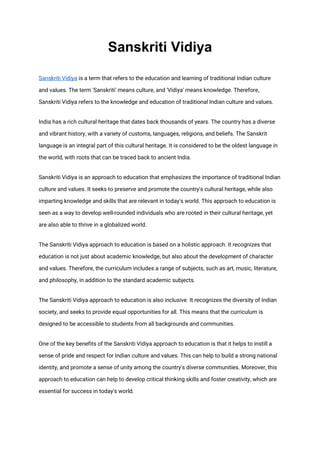Sanskriti Vidiya.pdf
- 1. Sanskriti Vidiya Sanskriti Vidiya is a term that refers to the education and learning of traditional Indian culture and values. The term 'Sanskriti' means culture, and 'Vidiya' means knowledge. Therefore, Sanskriti Vidiya refers to the knowledge and education of traditional Indian culture and values. India has a rich cultural heritage that dates back thousands of years. The country has a diverse and vibrant history, with a variety of customs, languages, religions, and beliefs. The Sanskrit language is an integral part of this cultural heritage. It is considered to be the oldest language in the world, with roots that can be traced back to ancient India. Sanskriti Vidiya is an approach to education that emphasizes the importance of traditional Indian culture and values. It seeks to preserve and promote the country's cultural heritage, while also imparting knowledge and skills that are relevant in today's world. This approach to education is seen as a way to develop well-rounded individuals who are rooted in their cultural heritage, yet are also able to thrive in a globalized world. The Sanskriti Vidiya approach to education is based on a holistic approach. It recognizes that education is not just about academic knowledge, but also about the development of character and values. Therefore, the curriculum includes a range of subjects, such as art, music, literature, and philosophy, in addition to the standard academic subjects. The Sanskriti Vidiya approach to education is also inclusive. It recognizes the diversity of Indian society, and seeks to provide equal opportunities for all. This means that the curriculum is designed to be accessible to students from all backgrounds and communities. One of the key benefits of the Sanskriti Vidiya approach to education is that it helps to instill a sense of pride and respect for Indian culture and values. This can help to build a strong national identity, and promote a sense of unity among the country's diverse communities. Moreover, this approach to education can help to develop critical thinking skills and foster creativity, which are essential for success in today's world.
- 2. There are a number of organizations and institutions in India that promote the Sanskriti Vidiya approach to education. These include schools, colleges, and cultural centers. Many of these organizations also offer programs and initiatives that help to preserve and promote traditional Indian culture and values. In conclusion, the Sanskriti Vidiya approach to education is an important way to preserve and promote India's cultural heritage. It is a holistic approach that recognizes the importance of character and values, in addition to academic knowledge. This approach to education can help to build a strong national identity, promote unity among diverse communities, and foster critical thinking and creativity. By embracing the Sanskriti Vidiya approach to education, India can continue to thrive as a culturally rich and diverse country. Make sure to visit our website from here

